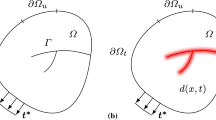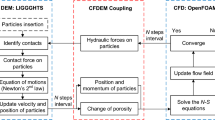Abstract
The objective of this work is not a fracture prediction or prevention. We are interested in modeling the crack network geometry in rocks and swelling soils and in the application of the model to rock volume fragmentation or preferential flow in swelling soils. Natural and explosion-induced rock fragmentation is important in geophysics and mining. Preferential flow in swelling soils is important in agricultural and environmental engineering. The presentation gives a brief review of the authors' work in this area. A concentration criterion of crack connection and effective independency of cracks in the case of multiple cracking are a basis for the modeling of a crack network. This basis enables one to introduce a condition of fragment formation at crack connection and a number of relevant concepts (an average cracking – an average crack number of x dimension in volume; crack connection probability of x dimension; fragment formation probability; average and maximum fragment dimensions; crack connectedness – a ratio connected to the total number of cracks; and crack network tortuosity), as well as to suggest quantitative relations between the concepts. In the frame of an application, the average fragment dimension and crack connectedness (or the maximum fragment dimension and fragment formation probability) can depend on the spatial coordinates and parameters specific for the application. The simplest application relates to the block-dimension distribution of a rock mass for statistically homogeneous conditions. The second application relates to the granulometric composition of a blasted rock mass in quarries. In this case the specific parameters are the preliminary rock disturbance (including natural cracking), charge construction, blasting scheme and others. The third application relates to the shrinkage crack network geometry in swelling clay soils, the spatial coordinate being the soil depth. The specific parameters are an upper layer thickness (of a few tens of centimeters) of intensive cracking and the maximum crack depth (its boundary being the depth of the water table level). Crack width, depth, spacing, volume, and tortuosity of the crack network are estimated by using the shrinkage curve of the soil and a water content profile. The fourth application relates to the hydraulic properties of capillary crack networks in swelling soils as compared to those of the soil matrix. For all the applications considered, comparison between the model prediction and available data shows good agreement.
Similar content being viewed by others
References
Azovtsev, S.N. (1984). Characteristic features of the structure and explosive disintegration of igneous rocks. In: Improving the Mining and Reprocessing Procedure for Mineral Ore [In Russian]. Izd. Minstroimaterialov SSSR, Moscow.
Chertkov, V.Y. (1986). Chip development during multiple crack formation in a brittle rock. Soviet Mining Science 21, 489-495.
Chertkov, V.Y. (1987). Model of fragment formation for short-delay detonation of a series of elongated charges in fissured rock. Soviet Mining Science 22, 447-455.
Chertkov, V.Y. (1991). Characteristics of the shape of blasted rock fragments. Soviet Mining Science 27(6), 528-532.
Chertkov, V.Y. (1995). Mathematical simulation of soil cloddiness. International Agrophysics 9, 197-200.
Chertkov, V.Y. (2000). Modeling the pore structure and shrinkage curve of soil clay matrix. Geoderma 95, 215-246.
Chertkov, V.Y. and Ravina, I. (1998). Modeling the crack network of swelling clay soils. Soil Science Society of America Journal 62(5), 1162-1171.
Chertkov, V.Y. and Ravina, I. (1999). Tortuosity of crack networks in swelling clay soils. Soil Science Society of America Journal 63, 1523-1530.
Chertkov, V.Y. and Ravina, I. (2002). Combined effect of interblock and interaggregate capillary cracks on the hydraulic conductivity of swelling clay soils. Water Resources Research 38(8), 10.1029/2000WR000094.
Curran, D.R., Shockey, D.A., Seaman, L. and Austin, M. (1977). (Stanford Research Institute, Menlo Park, California). Mechanisms and models of cratering in earth media. In: Impact and Explosion Cratering (Edited by D.J. Roddy, R.O. Repin and R.B. Merrill), Pergamon Press, New York, pp. 1057-1087.
Dasog, G.S., Acton, D.F., Mermut, A.R. and De Jong, E. (1988). Shrink-swell potential and cracking in clay soils of Saskatchewan. Canadian Journal of Soil. Science 68, 251-260.
Diamond, S. (1970). Pore size distributions in clays. Clays and Clay Minerals 18, 7-23.
Guidi, G., Pagliai, M. and Petruzzelli, G. (1978). Quantitative size evaluation of cracks and clods in artificially dried soil samples. Geoderma 19, 105-113.
Hudson, J.A. and Priest, S.D. (1979). Discontinuities and rock mass geometry. International Journal of Rock Mechanics, Mining Science, and Geomechanical Abstracts 16, 339-362.
Repin, N.Ya. (1978). Preparation and excavation of overburden of coal strip mines (in Russian), Nedra, Moscow, 256 p.
Ringrose-Voase, A.J. (1987). A scheme for the quantitative description of soil macrostructure by image analysis.Journal of Soil Science 38, 343-356.
Ringrose-Voase, A.J. and Bullock, P. (1984). The automatic recognition and measurement of soil pore types by image analysis and computer programs. Journal of Soil Science 35, 673-684.
Ringrose-Voase, A.J. and Nys, C. (1990). One-dimensional image analysis of soil structure. II. Interpretation of parameters with respect to four forest soil profiles. Journal of Soil Science 41, 513-527.
Scott, G.J.T., Webster, R. and Nortcliff, S. (1986). An analysis of crack pattern in clay soil: its density and orientation. Journal of Soil Science 37, 653-668.
Scott, G.J.T., Webster, R. and Nortcliff, S. (1988). The topology of pore structure in cracking clay soil. I. The estimation of numerical density. Journal of Soil Science 39, 303-314.
Velde, B., Moreau, E. and Terribile, F. (1996). Pore networks in an Italian Vertisol: quantitative characterisation by two dimensional image analysis. Geoderma 72, 271-285.
Yaalon, D.H. and Kalmar, D. (1984). Extent and dynamics of cracking in a heavy clay soil with xeric moisture regime, in Proceedings of ISSS Symposium on water and solute movement in heavy clay soils ILRI. (Edited by J. Bouma and P.A.C. Raats) Wageningen. The Netherlands, 45-48.
Zein el Abedine, A. and Robinson, G.H. (1971). A study on cracking in some vertisols of the Sudan. Geoderma 5, 229-241.
Zhurkov, S.N., Kuksenko, V.S. and Petrov, V.A. (1981). Physical principles of prediction of mechanical disintegration. Soviet Physics, Doklady 26, 755-757.
Author information
Authors and Affiliations
Rights and permissions
About this article
Cite this article
Chertkov, V.Y., Ravina, I. Networks originating from the multiple cracking of different scales in rocks and swelling soils. International Journal of Fracture 128, 263–270 (2004). https://doi.org/10.1023/B:FRAC.0000040989.82613.36
Issue Date:
DOI: https://doi.org/10.1023/B:FRAC.0000040989.82613.36




